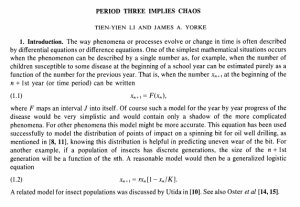
How about a Chaotic Genome Assembler?
Earlier we discussed about conifer genome assembly in two commentaries.
Steven Salzberg at #bog13: Assembling 22Gb Conifer Genome
#bog13 Posters on Pine and Coelacanth
One important point overlooked in the commentary was that University of Maryland (WMD) did most of the work on the whole-genome assembly with MaSuRCA, and the acronym itself stands for Maryland Super-Reads with Celera Assembler. The leaders of the UMD effort are Aleksey Zimin and Jim Yorke.

Dr. Yorke is a distinguished mathematician with major contribution in chaos theory. In 1975, he and his student Tien-Yien Li used the word ‘choas’ (as in chaos theory) for the first time in a very interesting paper - “Period Three Implies Chaos” (click on the image to read their paper).

For readers unfamiliar with chaos theory, it was one of the greatest advances in mathematics in 20th century. It showed that perturbation method of long-term forecast was invalid in many nonlinear systems, and ‘complex’ behavior in nature could be derived from simple nonlinear equations. As an example, try the following discrete equation -
If you increase r above 3.56995, the series will start to behave erratically. With a small change in r, you will see large divergence in the output over time.

We know what you are thinking. How did the biodiversity paper published in Nature (
Severe Biodiversity Loss Expected by Year 2080) predict future in 2080 given that even the simplest nonlinear system has chaotic uncertainty? Here is how. Chaos theory was considered to be the greatest mathematical discovery of 20th century, but it was extremely inconvenient for central planners, who wanted to convey feeling of certainty, confidence and omniscience. A theory that claimed to have changed long-term output dramatically with small change in input was completely unacceptable. For that reason, chaos theory was ‘disproved’ by a very famous inventor using a method better than mathematics, namely politics. Central planners never had to look back since then.

In the meanwhile, those of you still stuck in the mathematical glories of past century may enjoy our earlier commentary on complexity of sandpiles - What Does BTW Stand for?.